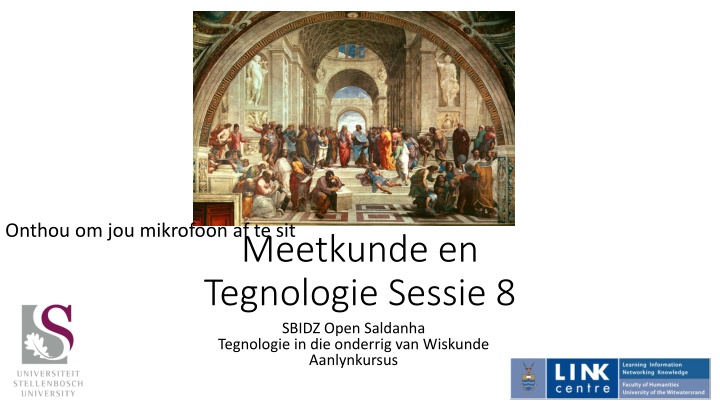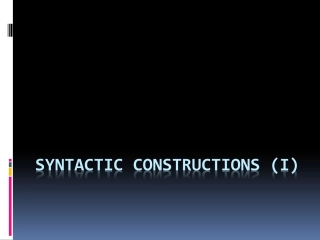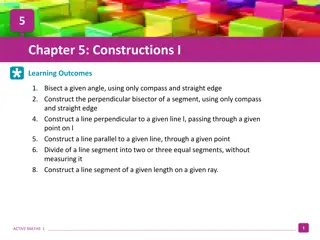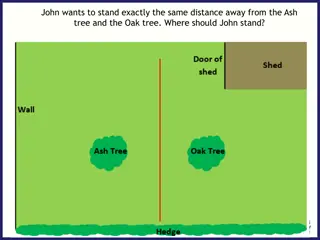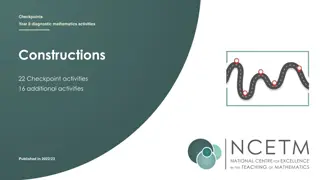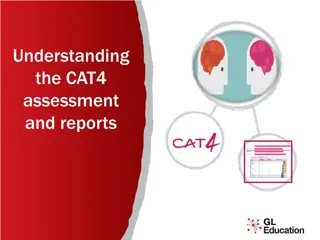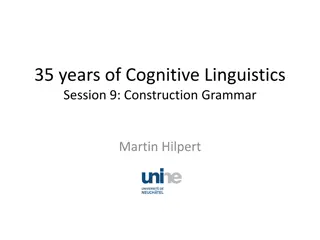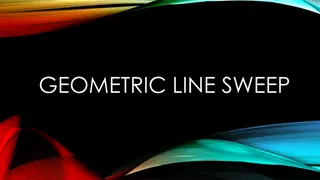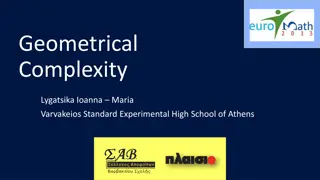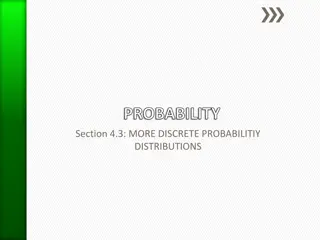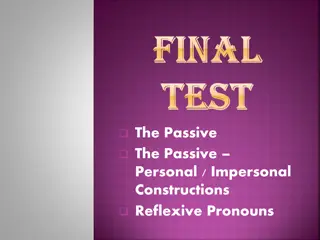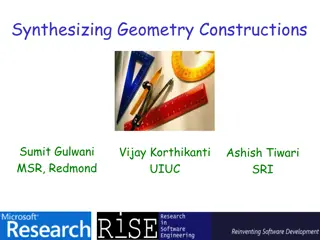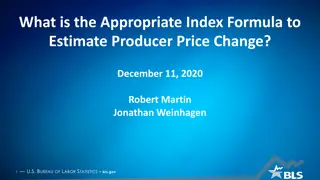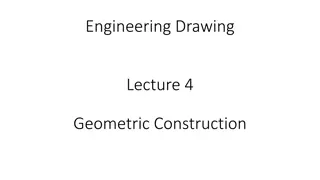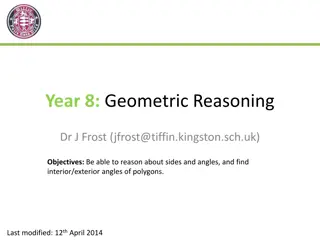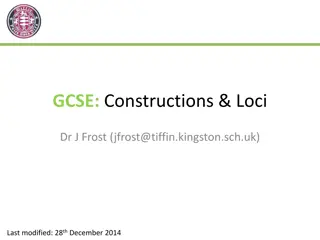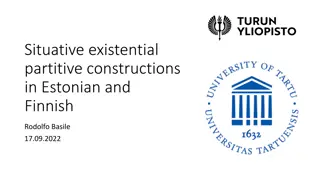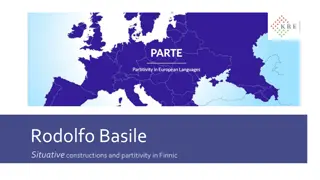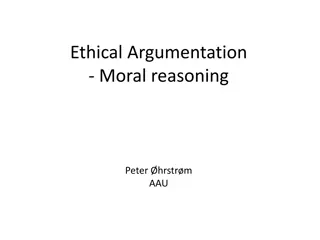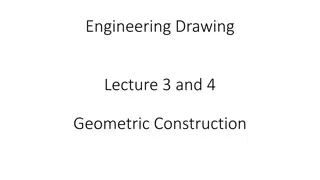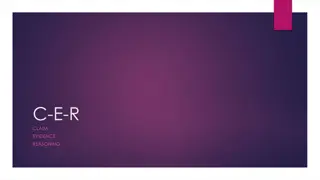Geometric Reasoning and Dynamic Constructions: Enhancing Learning Through Technology
Delve into the world of geometric reasoning and dynamic constructions in mathematics education. Explore the intersection of geometry, technology, and pedagogy to foster meaningful learning experiences. Session topics include geometric habits of mind, tools for reasoning, triangle constructions, and area measurement concepts. Teachers are guided on facilitating connections between geometric concepts and promoting proof-reasoning skills essential for students. Discover the progression from basic figure properties to advanced reasoning, culminating in developing clear definitions and proof-based thinking in the senior phase curriculum.
Uploaded on Apr 04, 2025 | 2 Views
Download Presentation

Please find below an Image/Link to download the presentation.
The content on the website is provided AS IS for your information and personal use only. It may not be sold, licensed, or shared on other websites without obtaining consent from the author.If you encounter any issues during the download, it is possible that the publisher has removed the file from their server.
You are allowed to download the files provided on this website for personal or commercial use, subject to the condition that they are used lawfully. All files are the property of their respective owners.
The content on the website is provided AS IS for your information and personal use only. It may not be sold, licensed, or shared on other websites without obtaining consent from the author.
E N D
Presentation Transcript
Onthou om jou mikrofoon af te sit Meetkunde en Tegnologie Sessie 8 SBIDZ Open Saldanha Tegnologie in die onderrig van Wiskunde Aanlynkursus
Looking back Tools determine reasoning o Affordances and constraints of the tool for meaningful learning o Advantages of using a dynamic tool o Geometric habits of mind for the 21st century o Session 2: You cannot believe your eyes. Reason! o Session 3: Constructions of a square: transformation tools, drag test Group reflection on DBE Use of Technology in schools o Session 4: Triangle sum constructions o Session 5: Equivalence, congruence o Session 6: From triangles to polygons o Session 7: The meanings of the Theorem for Pythagoras o Session 8: Geometric reasoning: Area GSP skills Constructing and drawing figures Constructing lines perpendicular to and parallel to another line Labelling and marking sides, vertices and angles Measuring side lengths and angles Transform figures: rotation, reflection, translation 2
The focus in Senior Phase is write clear definitions (Grade 8), once compareisons were made between properties of figures (Grade 7). The progression to Grade 9 is not in terms of content, but in terms of proof-reasoning. The teacher s task is to make connections between the content bullets, not to teach the content as a list: How are triangles related to quadrilaterals? How can we use triangle properties to reason about quadrilateral properties? 8
Session 6: Reasoning with dynamic constructions: Relationships between areas of (polygons) Session outline 16:00 16:30 What is the conceptual origin of area measurement; the development of area measurement in primary school; 16:30 17:00 From triangles (and other figures) to rectangles: cut and move; Area between parallel lines; scaling area (proportional reasoning) 17:00 17:30 From rectangles to squares; House keeping 9
Big ideas Area measure is based on the process of tessellating a plane figure with squares. Reasoning with transformations: all squares are similar, hence enlargements of each other, and we can hence choose squares of different sizes (scaled up or down) without any loss of generality Breaking up quadrilaterals (polygons) into triangles Transforming (by dissection and motion) triangles to rectangles and then to squares Units of measurement are completely arbitrary, hence we need to agree on a unit for the purpose of communication; and abstract the idea of unit as that chosen to represent 1 10
Die kubus hou ons meetstelsel The cube holds our measurement system Using an edge as unit, linear distance and length can be measured by iteration Using a face as unit, area can be measured by iteration Using the cube itself as a unit, volume can be measured by iteration 11
Area by enclosing in rectangles Enclose irregular parts in rectangles and reason about proportions Omsluit die onre lmatige dele in reghoeke en bedink die proporsionele verhoudings 12
Area by enclosing in a square What can you write about 40 by analysing the diagram? In Euklidiese meetkunde is vierkantwortels konstrueerbare lengtes 13
Area as tessellation Gee die grootte van parallelogram FGHI in terme van Die blou driehoek (4 x 8) x 2 Die oranje ruit (4 x 8) Die pers driehoek (4 x 8) x 2 /4 Many learners struggle to understand that the number of tessellating figures on the same area changes inversely proportional to the change in size of the tessellating unit Baie leerders sukkel om te verstaan dat die aantal figure wat n oppervlak tesselleer,omgekeerd eweredig is aan die grootte van die tessellerende figuur 14
Area and the midpoint cuts/Oppervlakte en halveerpunte N, R en P is middelpunte van die lynstukke waarop hulle l . Wat is die verhouding tussen die oppervlaktes van die groen driehoek en die geel driehoek? Hoe weet jy? Gee twee ander driehoeke met dieselfde verhouding tussen hulle oppervlaktes Wat is die verhouding tussen die oppervlaktes van die verskillende driehoeke en vierhoeke waarin driehoek MQO verdeel is. Gebruik GSP, Geogebra of Desmos om die verhoudings te toets nadat jy jou voorlopige stellings neergeskryf het. 15
Area of a trapezium: formula Making connections: What is the relationship between the area of a triangle and the area of a trapezium? With GSP you can drag point C towards B to consider the extreme case where the trapezium is a triangle. Reasoning with continuity: How does the area change as BC becomes shorter or longer? From a dissection perspective, draw one diagonal to cut the trapezium into two triangles From a transformation perspective, rotate the one parallel side to line up with the other parallel side and consider the triangles formed. 16
How to reconfigure a rectangle to a square without changing the area/ (Afr op volgende slide) If the side lengths of the rectangle are ? and ?, then the area of the square is ?? square units. So the side length of the square must be ?? units. Given lengths ? and ?, calculate the value of ?? . Use GSP to construct a segment with length ?? . (the help menu explains the procedure). With the centre of the circle at A, and radius ?? , find point x on side CD. The next quest is to cut the rectangle in such a way as to produce useful right angles. Hence construct a line through B, perpendicular to AX. Prove that BY is also ?? . Now it is a case of rotating, or sliding BY into the required positions to form the square. Use congruence and properties derived from sliding and rotation, to prove that the triangle parts are congruent. What is the area of the overlapping part? Does your GSP construction pass the drag test? 17
How to reconfigure a rectangle to a square without changing the area/ Hoe om n reghoek te vervorm na n vierkant met dieselfde oppervlakte As die sylengtges van die reghoek s ? en ? is, dan is die oppervlakte van die reghoek ?? vierkante eenhede. Die sylengte van die vierkant moet dus ?? eenhede wees. Kies lengtes vir die reghoeksye ? en ?, en bereken die lengte ?? . Gebruik GSP om n segment te konstrueer met lengte ?? . (Die Help menu gee die prosedure). Met die middelpunt van die sirkel by A, en radius ?? , vind die punt X op sy CD. Die volgende mikpunt is om die reghoek so the sny dat daar bruikbare regtehoeke vorm. Konstrueer dus n lyn deur B, loodreg op AX. Bewys dat die lengte van BY = ?? . Noudat ons twee gelyke sylengtges het wat loodreg op mekaar is, is dit net n kwessie van rotasie of skuif van die lynstuk BY om die vierkant te vorm. AX gee die skuifvektor. Gebruik die eienskappe wat verkry is deur die rotasie of skuiftransformasie om te bewys dat die driehoekdele kongruent is. Wat is die oppervlakte van die oorvleuelende gedeelte? 18
